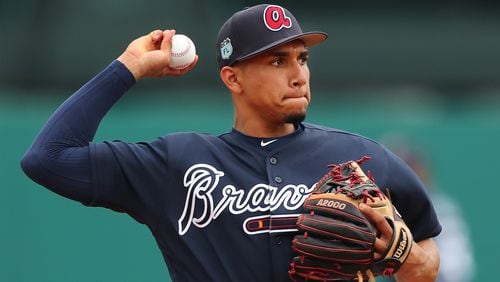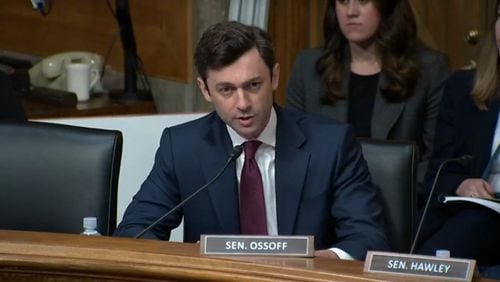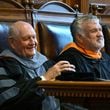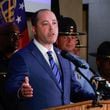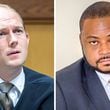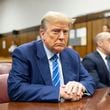The Braves enter spring training with a similar third-base situation to a season ago. That comes despite a winter of rumors and speculation that the team would add external help at the position.
Johan Camargo and Rio Ruiz, barring a late addition, will compete for the starting third-base job as the team reports this month. The team also has 20-year-old prospect Austin Riley, who it holds in high regard.
The Braves have been conscious of Riley’s status despite him logging just 48 games at the Double-A level. His presence dialed down the team’s urgency in adding a third baseman such as still-free agent Mike Moustakas.
“Our focus, unless it’s someone we really believe in, would be on a shorter term,” general manager Alex Anthopoulos said. “Because we don’t want to block a Riley, we don’t want to block an (outfield prospect Ronald) Acuna. At least not now until we have a better sense of who they are. Unless it’s a no-brainer deal and we’re going to get someone that we’re totally convinced on in the outfield or totally convinced on at third base.”
Camargo, 24, and Ruiz, 23, haven’t necessarily plagued themselves. They’re just generally viewed more as utilitymen than starters, for better or worse. Anthopoulos inherited both players when he accepted the job in December and wants to see more of each.
“Wants, needs; we’ve still kicked around third base,” Anthopoulos said last month. “We’ve talked about, ‘Is Camargo ready to be an everyday player? Should he get that opportunity, one way or the other? Rio is someone that we think there’s some things there with the bat. Should he get an opportunity as well? So do we bring someone in? Do we give those guys an opportunity? Are there potential long-term guys out there?”
Anthopoulos is about the long-term play. The Braves aren’t in position to win now. Finding out if they have their answer at third, be it Camargo, Ruiz or an up-and-comer, is paramount moving forward.
Ruiz appeared in 58 games in the past two seasons, hitting .197 with four home runs and 21 RBIs in 157 at-bats. He’s yet to play consistently, but neither his bat nor defense have provided much hope toward him fortifying the position.
Camargo became the Braves’ biggest surprise, hitting .299 with 27 RBIs and four homers in 241 at-bats. He’s proved to be a steady defender, and Anthopoulos took note of his strength during the Dominican winter league.
“I knew Camargo had a good arm, but watching some of the video, wow,” he said.
Neither candidate addresses arguably the Braves' biggest need: a middle-of-the-order bat to slot behind first baseman Freddie Freeman in the lineup. But that may be a weakness with which the team must live.
The Braves kept tabs on slugger Todd Frazier, who signed with the Mets a week ago. They’re reported to have interest in veteran Eduardo Nunez, who in some ways is a more seasoned version of Camargo.
Nunez slashed .313/.341/.460 while playing all over the infield and corner outfield in 2017. He stole 24 bases as well, another lacking area on the present-day Braves. While not regarded for his pop, Nunez hit eight homers with 12 doubles in his 38 games with the Red Sox following last season’s trade deadline.
His addition would give the Braves more flexibility if shortstop Dansby Swanson’s struggles were more than a one-season affair. Nunez or Camargo could supplant him at short if need be.
But unless Nunez’s price fits the team’s liking (and budget), it’ll be a two-man race at third.
The third-base competition directly affects how the team will fill out its bench. It’s probable the Braves elect to use an eight-man bullpen, leaving room for four extra men.
One spot will be filled by whichever of Tyler Flowers or Kurt Suzuki won’t be catching that day. Another will be filled by one member of a Lane Adams and Preston Tucker left-field platoon, or whoever is the fourth outfielder in the event Acuna starts opening day.
The other two slots are less certain.
Newcomer and Rome native Charlie Culberson is expected to take one of them. If Camargo starts, Culberson would seamlessly slide into his versatile role from a season ago.
If Anthopoulos adds a veteran third baseman, Camargo would be bumped to the bench, and Culberson’s place is a bit muddier, though he’d remain among the top candidates for a spot.
Ruiz, if not the starter, could face an uphill climb. Given that he’s strictly a third baseman, the team could opt for a more versatile option, in which case it would be mutually beneficial if Ruiz was sent to Triple-A. There’s little to gain by minimizing him on the bench, and he’d be given the chance to showcase himself for the Braves or another organization while starting in Gwinnett.
As for the non-roster invitees, the Braves brought back Danny Santana to compete for a bench job. The versatile Christian Colon came over from the Royals. There’s always the chance a younger player, outfielder Dustin Peterson for instance, fights his way into the discussion, as manager Brian Snitker has suggested in recent weeks.
“We like our young guys,” Snitker said. “We have a lot of young guys we want to know more about. Put them out there, let them get innings, at-bats. I think if the right free agent came about, yeah, it might make a difference. Realistically, some of our young players, everybody’s excited about them. We’ve been talking about them for how long? Now all of a sudden they show up, and I want to see them go.”
It’s not a perfect situation, but the Braves have options. For a team trying to identify its long-term pieces, third base and the bench are likely to see consistent experiments through the summer.
About the Author
